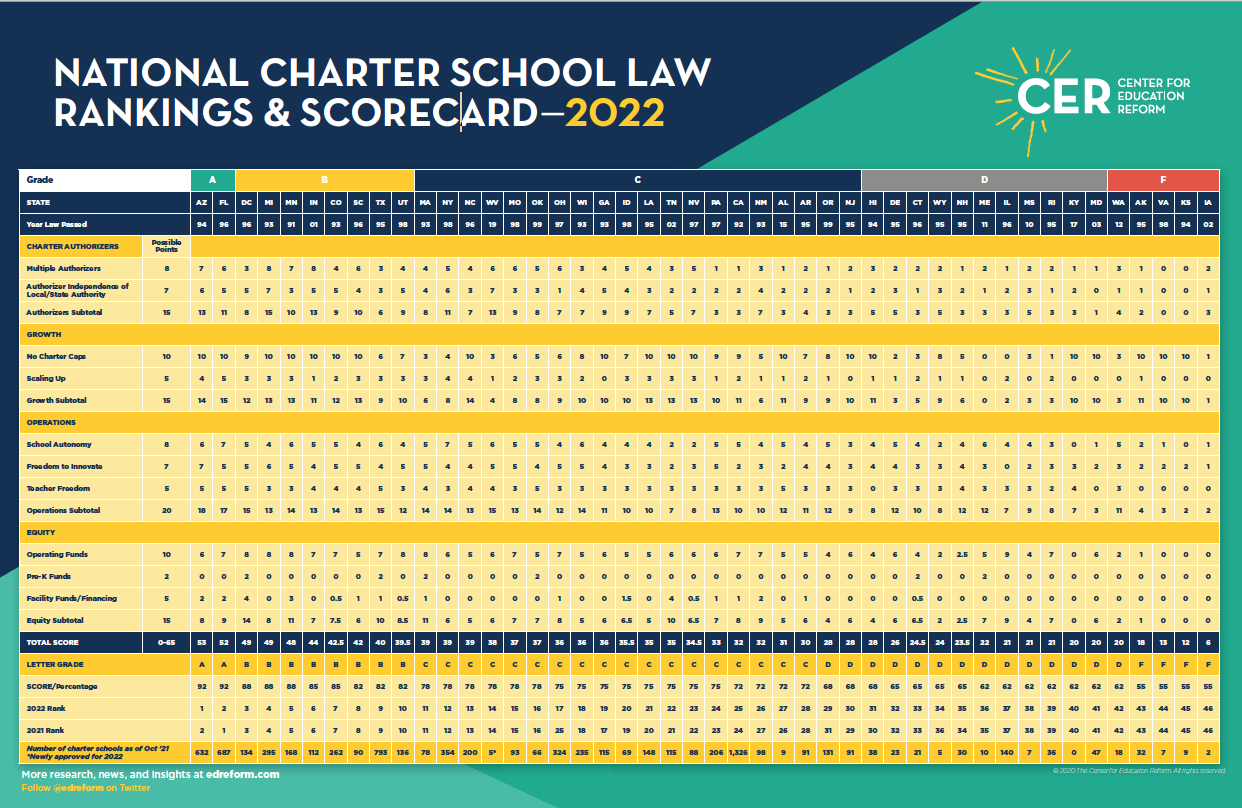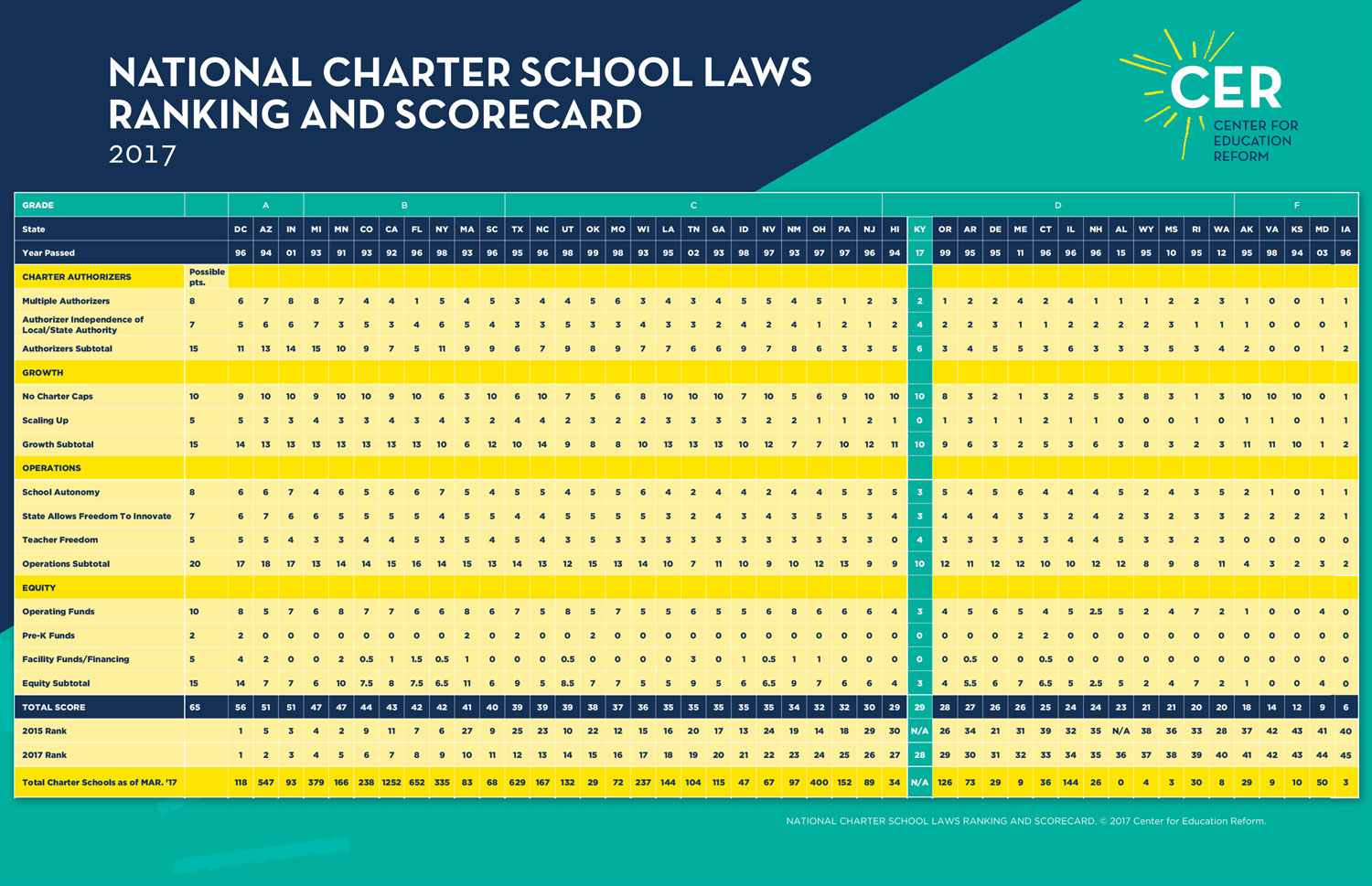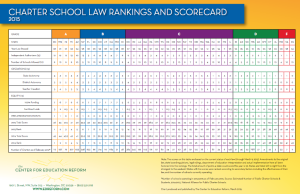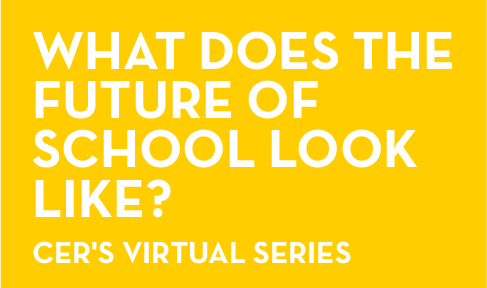National Charter School Law Rankings & Scorecard—2022:
 The simple and original principle of charter schooling is that charter schools should receive enhanced operational autonomy in exchange for being held strictly accountable for the outcomes they promise to achieve. When charter school laws honor this principle, innovative, academically excellent charter schools flourish. In turn, schools that fail to produce strong outcomes close.
The simple and original principle of charter schooling is that charter schools should receive enhanced operational autonomy in exchange for being held strictly accountable for the outcomes they promise to achieve. When charter school laws honor this principle, innovative, academically excellent charter schools flourish. In turn, schools that fail to produce strong outcomes close.
CLICK HERE TO VIEW THE NATIONAL CHARTER SCHOOL RANKINGS
Since the first charter schools were established in the 1990s, the movement has spread to every corner of the country, with concentrated growth in the nation’s largest urban centers. Over time, demand for charters has skyrocketed, despite setbacks deriving from weak charter school policies, overregulation, and false perceptions of charter schools promulgated by opponents of school choice.
One of the reasons parents and students seek charters is because, when they work, they offer options that are distinct from those found in most traditional school districts. The innovations that charters are best known for are extended school days and years and, in some places, one-to-one tutoring. But charters innovate in many other ways as well: from developing unique approaches to teacher training to pioneering tools for personalized learning, many innovations that are now accepted as common were born in the charter sector.
Also from CER:
Just the Facts: Success, Innovation, and Opportunity in Charter Schools (January 2017)
Charter schools are popular and innovative. They are also effective. But charter school success depends on the policy environments in which charter schools operate. Some state laws and regulations encourage diversity and innovation in the charter sector by providing multiple authorizers to support charter schools and allowing charters real operational autonomy. As Michael Q. McShane has pointed out, where diversity exists, charter schools have the opportunity to innovate.
Too many states, however, hamper charter schools with weak laws and needless regulations. These make it difficult to distinguish charters from their district counterparts.
Weak charter school laws have proven that when we apply the same old rules to district and charter schools, we get more of the same. Overregulation and underfunding force charters to behave as district schools by another name. Wouldn’t it make more sense to allow charters the room to innovate and succeed so that they could, in turn, help district schools subvert the status quo?
Since 1996 CER has researched, analyzed and ranked state charter school laws in an attempt to demonstrate how weak charter school laws create weak charter schools. These findings consider not only the content of each law, but also how the law impacts charter schools on the ground: How robust is the charter sector in each state? How diverse are the schools? To what extent do burdensome regulations prevent charters from doing anything meaningfully different?
CLICK HERE TO VIEW THE DETAILS BEHIND THE NATIONAL CHARTER SCHOOL RANKINGS
![]() Please click here for the official press release
Please click here for the official press release![]()
Review Prior Law Rankings to Learn about the progress we’ve made
National Charter School Laws Across the States Ranking & Scorecard
18th Edition March, 2018
As in years past, the national rankings carefully consider the impacts of overregulation, particularly on innovations in teaching and learning. And this year’s National Charter School Law Rankings & Scorecard goes a step further, providing case study examples of how regulations and other aspects of poorly conceived charter school policies impact charter operators and students. In addition to these case studies, CER also provides model legislation for policymakers to consider when crafting or amending charter school laws and regulations.
With this important guide, there is evidence-rich feedback and guidance to policymakers. With feedback and guidance, change is possible.
CLICK HERE TO VIEW THE 2018 NATIONAL CHARTER SCHOOL RANKINGS
National Charter School Laws Across the States Ranking & Scorecard
17th Edition March, 2017

We are now well into the third decade since Minnesota passed the first state charter statute. The number of charter schools has continued to increase each year at a steady but relatively slow pace. But this past year, that growth abruptly came to a near halt. Overall, the nation’s nearly 7,000 charter schools still serve a fairly small percentage of the total number of students receiving public education, roughly six percent. Some states and cities have far more market share and point the way to what healthy expansive choice does for the whole of public education.
CLICK HERE TO VIEW THE 2017 NATIONAL CHARTER SCHOOL RANKINGS
![]() Please click here for the official press release
Please click here for the official press release![]()
National Charter School Laws Across the States Ranking & Scorecard
16th Edition, 2015
 Charter School Law Rankings: Read CER’s 16th edition of Charter School Laws Across the States 2015 Rankings & Scorecard here.
Charter School Law Rankings: Read CER’s 16th edition of Charter School Laws Across the States 2015 Rankings & Scorecard here.
“It is abundantly clear that little to no progress has been made over the past year. Charter school growth does continue at a steady, nearly linear pace nationally, especially in states with charter laws graded ‘A’ or ‘B,’ but an even more accelerated pace would allow charter schools to play a more central role in addressing the demands and needs of our nation’s students.” Read More.
Compare how states stacked up previously with the 15th edition of Charter School Law Rankings. For older rankings and information, please contact us.
An Introduction to Charter School Laws
Before you can have charter schools, you must have a state charter school law. Forty-three states and the District of Columbia have enacted charter school laws, with Alabama being the latest in March 2015. (The seven states that do not have charter school laws are Kentucky, Montana, Nebraska, North Dakota, South Dakota, Vermont, and West Virginia.)
As is the case with most education laws, charter schools are born at the state level. Typically a group of concerned lawmakers drafts a bill that allows the creation of any number of charter schools throughout a state. The content of the charter law plays a large role in the relative success or failure of the charter schools that open within that state. CER has identified a number of factors that can work together to create an environment that promotes the growth and expansion of charter schools. Some of them are identified below.
- Number of Schools & Applications: The best charter laws do not limit the number of charter schools that can operate throughout the state. They also do not limit the number of students that can attend charter schools. Poorly written laws set restrictions on the types of charter schools allowed to operate (new starts, conversions, online schools), hindering parents’ ability to choose among numerous public schools. Strong charter school law allows many different types of groups to apply to open and start charter schools.
- Multiple Charter Authorizers: States that permit a number of entities to authorize charter schools, or provide applicants with a binding appeals process, encourage more activity than those that vest authorizing power in a single entity, particularly if that entity is the local school board. The goal is to give parents the most options possible, and having multiple authorizers helps reach this goal. Additionally, it is important that the authorizing entities have independent power from one another to prevent creating multiple authorizers “in name only.”
For more information on why multiple authorizers are important, please see our Multiple Authorizers Primer.
- Waivers & Legal Autonomy: A good charter law is one that automatically exempts charter schools from most of the school district’s laws and regulations. Of course no charter school is exempt from the most fundamental laws concerning civil rights. These waivers allow charter schools to innovate in ways that traditional public schools cannot.
- Full Funding & Fiscal Autonomy: A charter school needs to have control of its own finances to run efficiently. The charter school’s operators know the best way to spend funds, and charter law should reflect this need. Similarly, charter schools, as public schools, are entitled to receive the same amount of funds as all other conventional public schools. Many states and districts withhold money from individual charter schools due to fees and “administrative costs,” but the best laws provide full and equal funding for all public schools.
What does a strong charter law look like?
Charter Authorizing: The Truth About State Commissions:
Every few years there is a flurry of activity across the country to create or amend state charter school laws. This paper shows how and why lawmakers and policy advocates need to revisit what has become a dangerous trend in charter policy debates.
The Essential Guide to Charter School Lawmaking: Model Legislation for States
CER has developed a roadmap for policymakers and advocates that focuses on essential elements of charter school law: Independent and Multiple Authorizers, Number of Schools Allowed, Operations, and Quality. This framework is based on 20 years of experience working with charter school leaders, policymakers, and legal experts, and reflects what actually works – and what doesn’t – when it comes to ensuring sound charter school policy.
Which states have strong charter school laws?
Understanding Charter School Laws and How They Are Ranked:
Clarifying what you need to know for effective policymaking by pointing out how state policy reports differ from one another.
Every year, the Center for Education Reform rates state charter school policy based on four major components that determine the development and creation of high-quality, autonomous charter schools:
1) The existence of independent and/or multiple authorizers
2) The number of schools allowed and state caps
3) Operational and fiscal autonomy
4) Equitable funding
For more on these components, visit Charter School Law Rankings & Scorecard: The Rationale Behind the Rankings.
Get the latest Charter School Laws Across the States Rankings and Scorecard here.
School Choice Law
Are Choice Scholarships Programs Constitutional?
The strongest critics of choice scholarship programs claim that they violate the First Amendment (establishment of religion) if dollars are used for religiously affiliated schools. The First Amendment provides freedom of religion, not freedom from religion. Choice scholarship programs let parents choose where to direct their children’s education funds. The state is not imposing religion upon its citizens (a concern of the Founding Fathers), nor does offering parents the choice of a religious education for their children substantiate federal funding of religious institutions. As Clint Bolick, Vice President for Litigation at the Goldwater Institute observes:
All credible contemporary school choice proposals are constitutional.[Contemporary school choice programs] do not propose subsidizing religious schools, but merely include such schools within the range of educational options made available to a neutrally defined category of beneficiaries (usually economically disadvantaged families). No public funds are transmitted to religious schools except by the independent decisions of third parties. As the U.S. Supreme Court repeatedly has affirmed, such “attenuated financial benefit[s], ultimately controlled by the private choices of individual[s]”…are simply not within the contemplation of the Establishment Clause’s broad prohibition.
In 2002, the U.S. Supreme Court upheld the constitutionality of the Cleveland Ohio school choice program, ensuring that laws returning parental stewardship of state educational funds for their children will not be overturned at the federal level. For more on this historic case, see the legal summary and a special edition of CER Newswire for more analysis and what the opposition argues.
Which states allow for parents to choose the right educational option for their children? What are my legislators doing to improve school choice in my state?
CER outlines existing school choice programs in the states. The American Federation for Children also does a great job of highlighting Existing School Choice Programs. The Education Policy Center at the Independence Institute offers an amazing library of all the school choice laws.
Pay Education Fifty a visit to find out if your Governor supports school choice and charter schools.
If you want to make school choice happen where you live, check out ways to make it happen in the Take Action area of our website. It only takes 5 minutes to start taking back your schools.
















